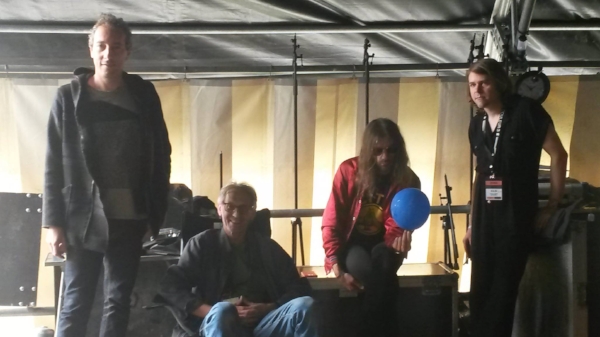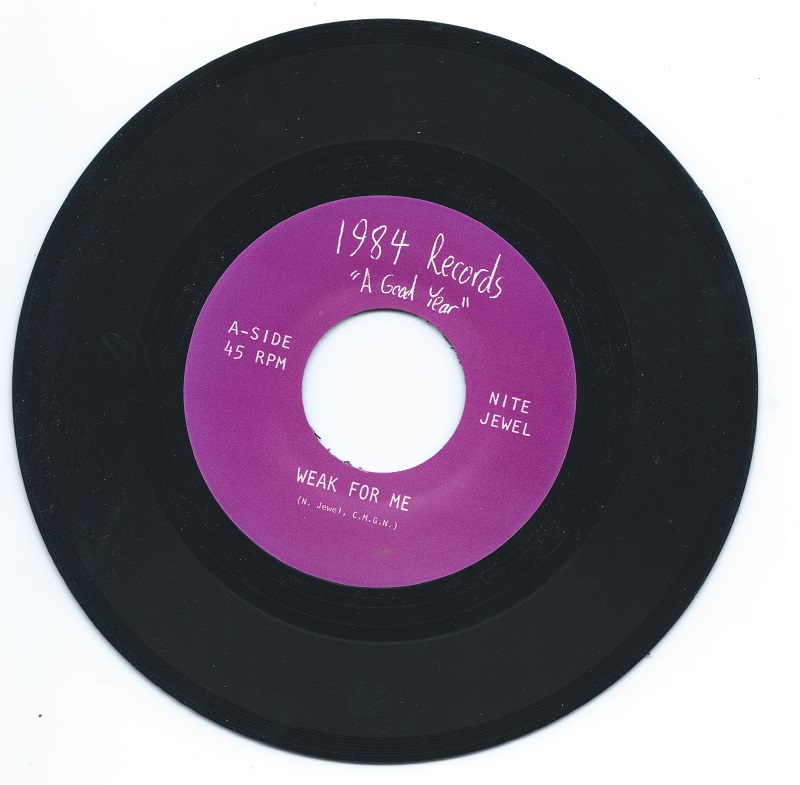Ash Ra Tempel Experience - Live in Melbourne
The Ash Ra Tempel Experience album was released in September 2017, and we've been fascinated by this gem since we got our hands on it. Not only does the album document a live performance of classic Ash Ra Tempel material performed by the renowned Ash Ra Tempel founder and sole consistent member Manuel Göttsching, but it also brings in an exciting trio of collaborators: Ariel Pink, Shags Chamberlain, and Oren Ambarchi. Eager to learn more about the background to Live in Melbourne, we spoke with Manuel Göttsching, Shags Chamberlain, and Supersense curator Sophia Brous about how this remarkable project came to fruition, and how it continues to evolve.
Bobby Weirdo: You mentioned that it surprised you that Ariel Pink, Shags Chamberlain, and Oren Ambarchi were familiar with your music.
Manuel Göttsching: Yes, this was a indeed a surprise. I was invited to this festival in Melbourne, Australia by Sophia Brous, who was curating the festival. I was supposed to play a solo concert in Melbourne at the Supersense Festival, and then she proposed a kind of session or workshop with some of the musicians also at the festival. I preferred having a concert, and my wife Ilona J. Ziok said I should play some old Ash Ra Tempel stuff. We looked at the websites of the musicians, and we liked the idea of performing with Ariel, Shags, and Oren very much.
I chose tracks from the 1972 Ash Ra Tempel albums Schwingungen and Seven Up, and was in touch with Ariel, Shags, and Oren by e-mail. I wanted to send them scores and the lyrics, and they said, “Are you joking? We know this music!” They told me they were very familiar with the music.
We met in Melbourne a day or two before the concert for a short afternoon rehearsal. Ariel was really into it. He wanted not only to sing, but also to play the bass, add special phasing effects to the bass, drums and guitar. So we had quite a complicated setup, but he made it work very well, and so did Oren on drums and Shags on synths, as you can hear on the album.
BW: You’ve mentioned in the past that the first Ash Ra Tempel album especially was more of a document than a produced piece of music. You wanted to capture the process of the live performance. It feels that way on Live in Melbourne as well; you didn’t cut it up or edit the album. It sounds like you recorded the entire performance as it happened, even keeping the talk between the songs. Is that actually what is on the album – the entire performance?
MG: It’s the entire performance. That’s what I wanted – a complete, live recording. I was very happy about the final mix that was done by Mick Glossop, a much respected and renowned UK producer and engineer, who has worked with Van Morrison, for example. I’ve known him since the late 1970s when we produced the Ashra album Correlations for Virgin Records. We had a fine multi-track recording from the Melbourne concert– 22 tracks or something like that. I wanted to keep it as much as possible like a live event, and that’s what he did. It’s a great mix.
BW: One of the unique moments on the Live in Melbourne album is the beginning of track 4, where I believe all four of you are at the vibes, playing at the same time. Is that what happened?
MG: Yes, that’s the idea. The original version had a vibraphone. I got one onstage, and I thought it would be nice if all four of us start [there], and then one after the other leaves the instrument. I think it was Ariel first, then Oren to the drums, then me to the guitar, and at the end, Shags. It’s a bit reminiscent to my favorite composer, Steve Reich, who composed music like 6 Pianos and 2 Marimbas.
BW: Are the parts that Ariel is singing on Live in Melbourne the parts that Timothy Leary sang?
MG: Yes. The four tracks [on Live in Melbourne] are a mix of some tracks from the album Schwingungen that have nothing to do with Timothy Leary, and the first side of Seven Up, which is from the album with Timothy Leary. They’re the original lyrics that he wrote. We also had two singers in our group [on Seven Up], so the singing was split. In the beginning the idea was not that Timothy Leary would sing. He just was supposed to write lyrics, and we had our singers. But then he began to talk, and he was so excited when we recorded it that he even started to sing in addition, and we loved it. Having been a professor at Harvard for neurology, the lyrics are about the seven levels of consciousness, based on a book Tim Leary was writing at the time He worked out the lyrics together with his partner Brian Barritt, a British writer. The lyrics are about the levels of consciousness, based on a book he was writing at the time. Therefore the seven parts and the name of the album.
BW: And are you happy with the Live in Melbourne album?
MG: Yes, and I’m also very happy with the cover. I’ve had a fantastic guy, Dirk Trageser, who’s been making album covers for me for the last twenty years, and I think this is one of his masterpieces. I like the recording, and I think the concert and release are just great.
BW: Some version of this Ash Ra Tempel lineup will be performing again next year right?
MG: We played a second show in summer 2016 in Switzerland at the Bonn Bad Kilbi Festival near the city of Berne. A funny coincidence – this was practically the close neighborhood where the original recordings of the album Seven Up with Timothy Leary actually took place in summer 1972. We performed another great show at The Barbican Centre, London, this year in March 2017, with a slightly different program, more focused on the first Ash Ra Tempel album. Of course, all of the concerts were recorded.
Yes, I am very much looking forward to our performing in Hamburg, Germany next year at the Elbphilharmonie. It’s scheduled for June 15 in Hamburg. We also are hoping to perform in the U.S. next year as well.
Bobby Weirdo: From the live standpoint, what was the audience response when you performed the music that would become the Live in Melbourne album?
Shags Chamberlain: The response was great; people were appreciative. This was the first gig we played together, and we all met the day before for a rehearsal. I wish we would have recorded some of the later gigs as well. [note: Good news for Ash Ra Tempel Experience fans regarding this - Manuel confirmed for WMF that "we have recorded all three concerts up to now – 2016 Switzerland and 2017 Barbican Centre in London as well."]
BW: It’s nice that the album is self-contained – if you had no introduction to what it was all about, you’d understand after a while because of the talk in-between songs. And you really feel like you’re in the moment when listening to the album.
SC: And that’s the good thing about it – it’s pretty raw, and it’s got that excitement. I think the mix captured what it was all about.
BW: How many of these shows did you end up doing?
SC: Three. For one of them - Bad Bonn Kilbi (Switzerland) – I don’t think we rehearsed. We sound-checked and then played the gig. But it was really great. We even played a song we had never played before – we just did it. It was simple enough, and Ariel and I had learned some songs ourselves just in the lounge room leading up to the first gig.
Bobby Weirdo: You played a big part in getting the artists for this project together for the performance that would become the Live in Melbourne album, right?
Sophia Brous: It was pretty amazing, because I know and love all four of the people involved – both directly and through their music. It was a really fun process. I’ve listened to and loved Ash Ra Tempel and Manuel Göttsching’s work for a long time.
It’s one of those opportunities you have when you’re a curator, wanting to creatively stream ideas with people, and that’s how I like to work. I wanted to think about how Manuel might reopen his Ash Ra Tempel and Ashra music within a new ensemble. I spoke with Manuel and Ilona about it for some time. We had different ideas, and the drummer was always a really important thing – finding someone with the right space/kraut sensibility. I suggested Oren.
The eclecticism of the people involved might in way reflect my interest in music. I’m a musician and a curator and do a lot of different stuff in music, but I like looking at the different faces of creativity within one artist. I knew about Ariel, Oren, and Shags, and that they were all fans of Ash Ra Tempel’s music, so it felt like a natural connection.
BW: Did you know ahead of time that Ariel, Shags, and Oren were familiar Ash Ra Tempel's music?
SB: I just assumed, really. Manuel is a seminal artist with a catalog of legendary, amazing stuff. So I felt it was a fair assumption. Shags Chamberlain is a person and musician I’ve known for many years. We have a long-standing friendship and association, and have played a lot of music together. We used to listen to Ash Ra Tempel together.
So I approached Shags, and then we discussed Ariel, and then I suggested Oren. It came together, and I think it’s always nice with these things where a grouping like this can continue. When you bring a bunch of people together and something kind of special and magical happens, it’s a great thing if it can continue to happen, so it’s not entirely in an ephemeral realm. That often happens in these kind of collaborative settings, but I’m really glad that Ilona and Manuel didn’t let that happen.
I get a real kick out of seeing someone like Ariel Pink, who arguably is a visionary voice of his generation alongside someone like Manuel, because I think they’re peers, and generations shouldn’t separate people collaborating.
You can purchase Live in Melbourne here.





